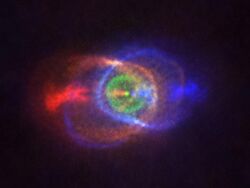Post common envelope binary
Topic: Astronomy
 From HandWiki - Reading time: 5 min
From HandWiki - Reading time: 5 min

A post-common envelope binary (PCEB) or pre-cataclysmic variable is a binary system consisting of a white dwarf or hot subdwarf and a main-sequence star or a brown dwarf.[1] The star or brown dwarf shared a common envelope with the white dwarf progenitor in the red giant phase. In this scenario the star or brown dwarf loses angular momentum as it orbits within the envelope, eventually leaving a main-sequence star and white dwarf in a short-period orbit. A PCEB will continue to lose angular momentum via magnetic braking and gravitational waves and will eventually begin mass-transfer, resulting in a cataclysmic variable. While there are thousands of PCEBs known, there are only a few eclipsing PCEBs, also called ePCEBs.[2] Even more rare are PCEBs with a brown dwarf as the secondary.[1] A brown dwarf with a mass lower than 20 |♃|J}}}}}} might evaporate during the common envelope phase and therefore the secondary is supposed to have a mass higher than 20 MJ.[3]
The material ejected from the common envelope forms a planetary nebula. One in five planetary nebulae are ejected from common envelopes, but this might be an underestimate. A planetary nebula formed by a common envelope system usually shows a bipolar structure.[4]
The suspected PCEB HD 101584 is surrounded by a complex nebula. During the common envelope phase the red giant phase of the primary was terminated prematurely, avoiding a stellar merger. The remaining hydrogen envelope of HD 101584 was ejected during the interaction between the red giant and the companion and it now forms the circumstellar medium around the binary.[5]
Many eclipsing post-common envelope binaries show variations in the timing of eclipses, the cause of which is uncertain. While orbiting exoplanets are often proposed as the cause of these variations, planetary models often fail to predict subsequent changes in eclipse timing. Other proposed causes, such as the Applegate mechanism, often cannot fully explain the observed eclipse timing variations either.[6]
List of post-common envelope binaries
Sorted by increasing orbital period.
| Name | Period | Secondary | Note |
|---|---|---|---|
| SDSS J1205-0242 | 71.2 minutes[7] | low-mass star or brown dwarf | shortest period PCEB (as of 2017) |
| WD 0137−349 | 116 minutes | brown dwarf | first confirmed PCEB with a brown dwarf as a companion |
| CSS21055 | 121.73 minutes[8] | brown dwarf | eclipsing binary |
| SDSS 1557 | 2.27 hours[9] | brown dwarf | circumbinary debris disk with a polluted white dwarf |
| V470 Camelopardalis (HS0705+6700) |
2.3 hours[6] | red dwarf | eclipsing binary |
| NY Virginis | 2.4 hours[6] | red dwarf | eclipsing binary |
| NSVS 14256825 | 2.6 hours[6] | red dwarf | eclipsing binary |
| HW Virginis | 2.8 hours[6] | red dwarf | eclipsing binary |
| NN Serpentis | 3.12 hours[6] | red dwarf | eclipsing binary |
| WD 0837+185 | 4.2 hours[10] | brown dwarf | extreme mass ratio of the progenitor, with the primary having a mass of 3.5-3.7 M☉ and the secondary 25-30 MJ |
| RR Caeli | 7.3 hours[6] | red dwarf | eclipsing binary |
| DE Canum Venaticorum | 8.7 hours[6] | red dwarf | eclipsing binary |
| central source of Hen 2-11 | 14.616 hours[11] | K-type main sequence star | planetary nebula and eclipsing binary |
| K 1-2 | 16.2192 hours[12] | planetary nebula | |
| central source of Fleming 1 | 1.1953 days[13] | white dwarf | planetary nebula |
| KOI-256 | 1.37865 days[2] | red dwarf | eclipsing binary |
| central source of NGC 2392 | 1.9 days[14] | hot white dwarf | planetary nebula and x-ray binary |
| central source of NGC 5189 | 4.04 days[15] | massive white dwarf | planetary nebula; primary is a low-mass Wolf-Rayet star |
| central source of NGC 2346 | 16 days[16] | >3.5 M☉ sub-giant | planetary nebula; one of the longest period PCEB which could host the most massive secondary |
| HD 101584 | 150–200 days[5] | red dwarf or white dwarf | the engulfment of the companion probably triggered gas to outflow, creating the nebula, seen with Hubble and ALMA; primary is a post-RGB star |
See also
- Cataclysmic variable
References
- ↑ 1.0 1.1 Casewell, S. L.; Braker, I. P.; Parsons, S. G.; Hermes, J. J.; Burleigh, M. R.; Belardi, C.; Chaushev, A.; Finch, N. L. et al. (2018-05-01). "The first sub-70 minute non-interacting WD-BD system: EPIC212235321". Monthly Notices of the Royal Astronomical Society 476 (1): 1405–1411. doi:10.1093/mnras/sty245. ISSN 0035-8711. Bibcode: 2018MNRAS.476.1405C.
- ↑ 2.0 2.1 Muirhead, Philip S.; Vanderburg, Andrew; Shporer, Avi; Becker, Juliette; Swift, Jonathan J.; Lloyd, James P.; Fuller, Jim; Zhao, Ming et al. (2013-04-02). "Characterizing the Cool KOIs. V. KOI-256: A Mutually Eclipsing Post-Common Envelope Binary". The Astrophysical Journal 767 (2): 111. doi:10.1088/0004-637X/767/2/111. ISSN 0004-637X. Bibcode: 2013ApJ...767..111M.
- ↑ "A Sub-Stellar Jonah – Brown Dwarf Survives Being Swallowed" (in en). https://www.eso.org/public/news/eso0628/.
- ↑ De Marco, Orsola; Reichardt, T.; Iaconi, R.; Hillwig, T.; Jacoby, G. H.; Keller, D.; Izzard, R. G.; Nordhaus, J. et al. (October 2017). "Post-common envelope PN, fundamental or irrelevant?" (in en). Proceedings of the International Astronomical Union 323: 213–217. doi:10.1017/S1743921317002149. ISSN 1743-9221. Bibcode: 2017IAUS..323..213D.
- ↑ 5.0 5.1 Olofsson, H.; Khouri, T.; Maercker, M.; Bergman, P.; Doan, L.; Tafoya, D.; Vlemmings, W. H. T.; Humphreys, E. M. L. et al. (March 2019). "HD 101584: circumstellar characteristics and evolutionary status" (in en). Astronomy & Astrophysics 623: A153. doi:10.1051/0004-6361/201834897. ISSN 0004-6361. Bibcode: 2019A&A...623A.153O.
- ↑ 6.0 6.1 6.2 6.3 6.4 6.5 6.6 6.7 Pulley, D.; Sharp, I. D.; Mallett, J.; von Harrach, S. (August 2022). "Eclipse timing variations in post-common envelope binaries: Are they a reliable indicator of circumbinary companions?". Monthly Notices of the Royal Astronomical Society 514 (4): 5725–5738. doi:10.1093/mnras/stac1676. Bibcode: 2022MNRAS.514.5725P.
- ↑ Rappaport, S.; Vanderburg, A.; Nelson, L.; Gary, B. L.; Kaye, T. G.; Kalomeni, B.; Howell, S. B.; Thorstensen, J. R. et al. (October 2017). "WD 1202-024: the shortest-period pre-cataclysmic variable" (in en). Monthly Notices of the Royal Astronomical Society 471 (1): 948–961. doi:10.1093/mnras/stx1611. ISSN 0035-8711. Bibcode: 2017MNRAS.471..948R.
- ↑ Beuermann, K.; Dreizler, S.; Hessman, F. V.; Backhaus, U.; Boesch, A.; Husser, T.-O.; Nortmann, L.; Schmelev, A. et al. (October 2013). "The eclipsing post-common envelope binary CSS21055: a white dwarf with a probable brown-dwarf companion" (in en). Astronomy & Astrophysics 558: A96. doi:10.1051/0004-6361/201322241. ISSN 0004-6361. Bibcode: 2013A&A...558A..96B.
- ↑ Farihi, J.; Parsons, S. G.; Gänsicke, B. T. (March 2017). "A circumbinary debris disk in a polluted white dwarf system" (in en). Nature Astronomy 1 (3): 0032. doi:10.1038/s41550-016-0032. ISSN 2397-3366. Bibcode: 2017NatAs...1E..32F.
- ↑ Casewell, S. L.; Burleigh, M. R.; Wynn, G. A.; Alexander, R. D.; Napiwotzki, R.; Lawrie, K. A.; Dobbie, P. D.; Jameson, R. F. et al. (November 2012). "WD0837+185: The Formation and Evolution of an Extreme Mass-ratio White-dwarf-Brown-dwarf Binary in Praesepe" (in en). The Astrophysical Journal 759 (2): L34. doi:10.1088/2041-8205/759/2/L34. ISSN 0004-637X. Bibcode: 2012ApJ...759L..34C.
- ↑ Jones, D.; Boffin, H. M. J.; Miszalski, B.; Wesson, R.; Corradi, R. L. M.; Tyndall, A. A. (February 2014). "The post-common-envelope, binary central star of the planetary nebula Hen 2–11" (in en). Astronomy & Astrophysics 562: A89. doi:10.1051/0004-6361/201322797. ISSN 0004-6361. Bibcode: 2014A&A...562A..89J.
- ↑ Ritter, H.; Kolb, U. (June 2003). "Catalogue of cataclysmic binaries, low-mass X-ray binaries and related objects (Seventh edition)" (in en). Astronomy & Astrophysics 404: 301–303. doi:10.1051/0004-6361:20030330. ISSN 0004-6361. Bibcode: 2003A&A...404..301R.
- ↑ Boffin, Henri M. J.; Miszalski, Brent; Rauch, Thomas; Jones, David; Corradi, Romano L. M.; Napiwotzki, Ralf; Day-Jones, Avril C.; Köppen, Joachim (November 2012). "An Interacting Binary System Powers Precessing Outflows of an Evolved Star" (in en). Science 338 (6108): 773–5. doi:10.1126/science.1225386. ISSN 0036-8075. PMID 23139326. Bibcode: 2012Sci...338..773B.
- ↑ Miszalski, Brent; Manick, Rajeev; Van Winckel, Hans; Escorza, Ana (May 2019). "The post-common-envelope X-ray binary nucleus of the planetary nebula NGC 2392" (in en). Publications of the Astronomical Society of Australia 36: e018. doi:10.1017/pasa.2019.11. ISSN 1323-3580. Bibcode: 2019PASA...36...18M.
- ↑ Manick, Rajeev; Miszalski, Brent; McBride, Vanessa (April 2015). "A radial velocity survey for post-common-envelope Wolf-Rayet central stars of planetary nebulae: first results and discovery of the close binary nucleus of NGC 5189" (in en). Monthly Notices of the Royal Astronomical Society 448 (2): 1789–1806. doi:10.1093/mnras/stv074. ISSN 0035-8711. Bibcode: 2015MNRAS.448.1789M.
- ↑ Brown, Alex J.; Jones, David; Boffin, Henri M. J.; Van Winckel, Hans (February 2019). "On the post-common-envelope central star of the planetary nebula NGC 2346" (in en). Monthly Notices of the Royal Astronomical Society 482 (4): 4951–4955. doi:10.1093/mnras/sty2986. ISSN 0035-8711. Bibcode: 2019MNRAS.482.4951B.
 |
 KSF
KSF
